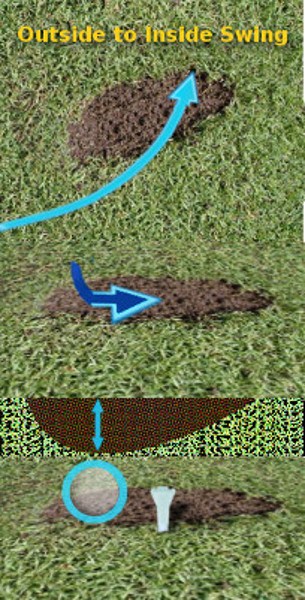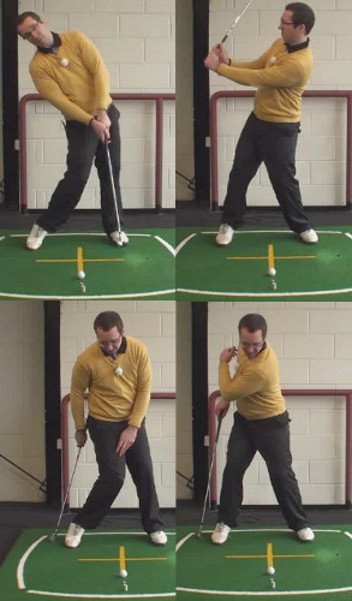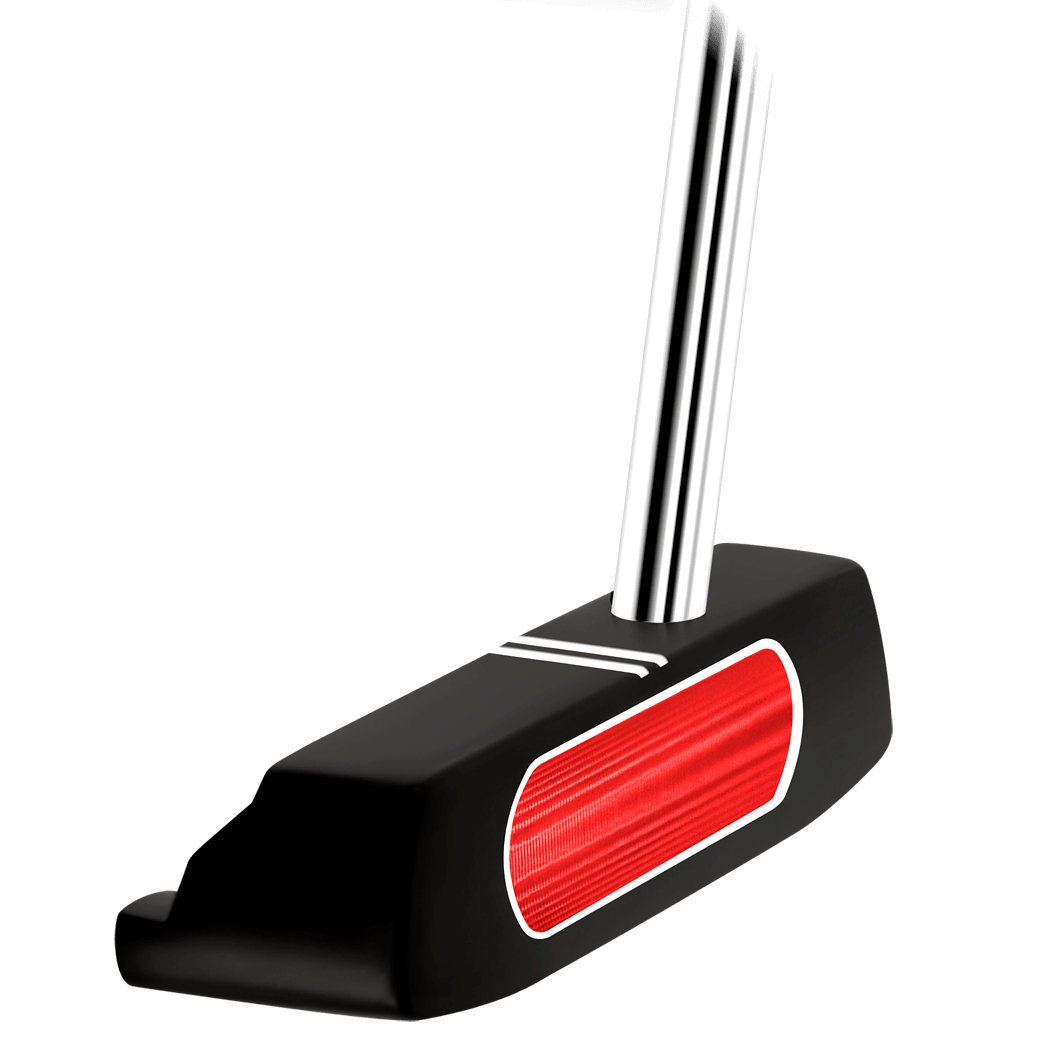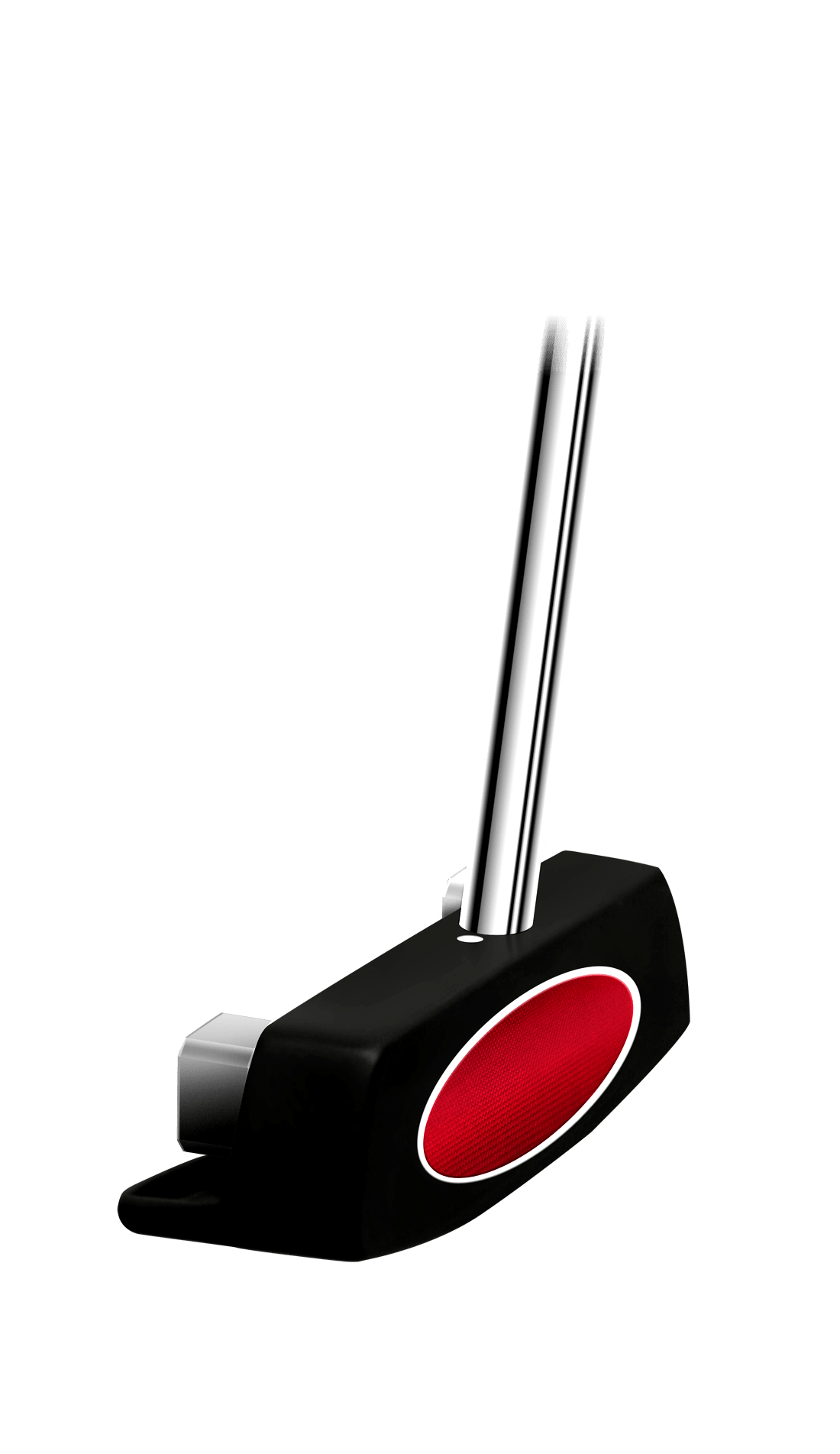
A divot is the piece of turf cut out of the ground by a golf club in making a stroke.
This piece of turf must be cut in order to make a proper golf stroke. Does the divot ever get recognition? I hear “nice ball” or “good golf shot” on the golf course but I hardly ever hear “great divot” or “great turf cut”. Hitting a good divot is the first sight of a good golf stroke.
A common divot flight is left; there are a few reasons for this. One reason could be the alignment to the golf ball. When the golf ball is in the front of the stance, playing off of the front foot, it is hard to hit the golf ball square and straight. When the ball is in the front of the stance, the club head will hit the ground first causing the impact of the ball to be on the upswing.
When this is the case the ball can be topped and the divot flying out to the left.
Having the ball in the front of the stance can also cause the swing to hit too much earth, in golf terms, hitting the ball fat. When the divot is hit before the ball, the contact of the club has already used its full potential on the ground and not the ball. The head speed of the club will be slowed down substantially. The swing is on its completion before hitting the ball causing your divot to travel left and having a poor strike.
A quick drill to fix this problem is by putting a tee in the ground about two inches in front of the ball. Now try hitting that tee after hitting the ball. This will imprint muscle memory on contact and keeping the club square to the target. This drill will also improve striking the ball first before the ground. Also imagine making the divot before the shot; the starting point, flight, and thickness of the divot that a good shot makes.
Another reason for having your divot point left of the target line is having too much tension in the right grip. Squeezing the club too hard with the right hand causes a chain reaction throughout the body in the back swing. The tension in the right hand makes the right arm more dominate than the left on the down swing causing the right side of the body to meet first with the ball. When this happens the divot will fly out left and soon the ball as well, causing a hook or a topspin pull.
Being knowledgeable about the divot direction and flight can fix one's swing early in a round and studying the divot will lower one's score and feel more confident at the approach of the ball.
Make sure always to replace your divots

Divots Pointing Left of the Target Line – What Does It Mean?
You can learn a lot from your divots. While you might think of a divot as something that simply needs to be replaced before you move on to your next shot, it can actually be a helpful teaching tool. By watching your divots carefully, you can learn about the swing that you are making out on the course. The patch of grass that you tear out of the ground will follow the path of your club through the hitting area, meaning that your divot provides instant feedback on the direction your club was moving when you hit the ball. This is highly valuable information, and ignoring your divots is a missed opportunity to improve your game.
One of the classic signs of trouble in your golf swing is when your divots are pointing to the left of the target line (for a right handed golfer). Ideally, you would like to see your divot pointing straight down the target line (or just slightly angled to the right or left). However, if your divot is significantly left of the target, you can be sure that there is a problem in your swing. The sooner you can straighten out the pattern of your divots, the sooner you can begin to hit better golf shots.
It is only helpful to identify this problem with your divot pattern if you are able to do something to fix it. Your game isn't going to get better just by noticing that your divots are pointing left – you have to take that information with you to the practice range and make changes to your swing in order to improve. Realistically, your swing is going to require some major changes in order to straighten out your divots. Swinging across the ball from right to left is a major mistake, and minor swing changes likely won't be enough to get you back on track. Be ready to alter your swing significantly if you would like to reach new levels of ball striking.
Looking at just one or two divots isn't going to be sufficient evidence to warrant a dramatic change to your swing. Instead, you should be watching your divots on a regular basis to spot patterns and trends within your swing. Make it a point to take a close look at every divot you make during your next round of golf. By the end of the round, you will have taken plenty of divots and you should have a very clear picture of what kind of pattern is prevalent in your swing. Armed with plenty of evidence, you can then get to work on improving your swing technique.
All of the instruction below is based on a right handed golfer. If you happen to play left handed, please reverse the directions as necessary.

Accurately Evaluating Your Divots
Information about your golf swing is only useful if it's accurate. If you are reading your divots – but reading them incorrectly – you will be doing more harm than good to your golf swing. It is vital that you pay close attention to how you are reading your divots so that you can get the right information each and every time.
The first point you need to understand is that your divot should always be compared to the target line of your shot. This is not necessarily the same thing as a line between your ball and the hole. For example, imaging that you are hitting an approach shot into a green that is guarded by water on the right. To avoid the water, you decide to aim left of the hole toward the big part of the green. You make a great swing, strike the ball cleanly, and the ball lands softly on the putting surface. You have executed your game plan perfectly.
However, when you look down at your divot, you notice that it is pointing well left of the target. What happened? Did you come over the top and swipe across the ball at impact? No – you aimed to the left! Always compare the path of your divot to the intended target line of the shot, even if that line is different than the line going toward the hole. In this case, since your intended target was the left side of the green, you should be happy to see that your divot is pointing in that direction. It would only be a problem if your divot was pointed even farther left and away from the green.
If you are able to practice on a natural grass driving range, you can use that opportunity to observe your divots in a controlled environment. Since there won't be any pace of play to worry about (like there is on the course), you can take your time to evaluate each divot and check the progress of your swing. When practicing on the range, you will still need to pick a very specific target line so you can compare your results after the shot. Take your time between each shot and try your best to make quality swings just as you would on the course. Over the period of just one or two practice sessions, you can gather as much data on your swing as you would get from five or six rounds of golf.
Of course, not all driving ranges have natural grass, as many have transitioned to artificial mats. If you are forced to hit practice balls off of mats, you won't be able to do your divot work on the range. Instead, you will have to use only the shots you hit on the course as a method of review. When you do review your divots on the course, do so quickly so you don't slow down play for everyone else. Take a quick look down at your divot after your shot, and compare its direction to the intended target line. It should only take a few seconds to check out your divot, and you can then pick up your bag and be on your way.

Three Causes of Divots Pointing Left
Once you determine that your divots are, in fact, pointing to the left of the target line, the next step is to figure out what is going wrong in your swing. You are never going to reach your potential on the course while you are swiping across the ball at impact, so it is crucial that you solve this puzzle as soon as possible. When you are able to deliver the club directly into the back of the ball on a good path (creating a divot that points at your target), you will instantly notice an improvement in power and the overall quality of content on your shots.
Following are three common causes of divots that point to the left of your target.
- Standing too close to the ball. If you take your stance too close to the ball at address, you will almost always end up with a swing that slices across the ball from right to left. It is simply a problem of not having enough space to make your swing. In a good golf swing, the club is delivered from the inside so that a full release can send the club head traveling perfectly down the target line. However, if you are standing right next to the ball, you won't have room to swing from the inside. Instead, you will have to bring your hands down steeply from the outside, and the result will be a divot that points to the left of the target. Obviously, there is a simple solution to this problem – stand farther away from the ball. However, once you do move back from the ball at address, you are then going to need to correct the flawed mechanics that you have developed to accommodate your close stance. After you move back, work on making a wide backswing that gives you plenty of room to drop the club to the inside during the downswing.
- Poor takeaway. The ideal takeaway will have the hands remain quiet while your shoulders and torso do the work of moving the club head away from the ball. Unfortunately, most amateur golfers make a mess of the takeaway portion of the swing. If you use your hands too actively early in the swing, the club will be moved to the inside of the proper path. When that happens, your backswing will be narrow, and you will have to move the club 'over the top' during the transition. This is a classic move for someone who struggles with a slice. To get back on track, stop using your hand so much early in the swing, and allow your big muscles to get things started. Once you are about halfway through your backswing, your hands can begin to get involved in the action. Correcting this common error can go a long way toward getting your divots to point at the target.
- Reverse pivot. Another common amateur mistake is known as a reverse pivot. When a reverse pivot occurs, your weight will be moving away from the target during the downswing (instead of toward the target). This error causes a long list of problems. While your weight is moving to the right, it is forcing the club to take an outside-in path to the ball. Yet again, the result of this mistake is a divot that points well to the left of the target. Of the three swing problems listed in this section, the reverse pivot is the one which will take the most effort to correct. If you have a reverse pivot in your swing, you are going to need to totally rework the way you swing the club in order to get your path on track. It can be done, certainly, but plan on putting in plenty of work at the driving range along the way. Fixing the reverse pivot starts with staying balanced during the backswing. As long as you can keep your weight centered between your two feet in the backswing, you should find it much easier to rotate to the left in the downswing.
There is a good chance that your divot problems are based in one of the three swing mistakes above. It is going to be up to you to take a close look at your swing to determine which of these causes is to blame. If possible, record your swing on video so you can get a good look at your mechanics. It should only take a few minutes of watching your swing on tape for you to determine what is going wrong in your swing. However, if you are still stumped even after watching the video, consider taking a golf lesson with a local pro who can help you break down the mechanics of your swing to isolate the issue that is leading to a poor swing path.

Self-Correcting on the Golf Course
To put your swing path problems permanently behind you, it will be necessary to spend plenty of quality time on the driving range. Of course, you can't exactly do that in the middle of a round of golf. If you notice that your divots are pointing to the left of your targets and you are only on the fourth hole, you will need to find a way to get the ball around the course for the rest of the day first. The long term fixes will have to wait – at this point, you need a quick fix that can help you keep the ball in play.
It isn't a good idea to try changing major parts of your swing mechanics while you are in the middle of a round. There is too much going on during a round to change your technique, and those kinds of changes take hundreds or thousands of swings to really be effective. However, you can make minor adjustments to help correct your swing problems and get better results from your ball flight. These adjustments aren't meant as a permanent fix – they are simply a temporary solution.
When you find that your divots are pointing left on the course, try using one or more of the temporary solutions below to get through the round as successfully as possible.
- Slower tempo. Many players who struggle with an outside-in swing also use a quick tempo. To straighten out your divot pattern quickly, try using a slower swing to allow your body to get into better positions. A slower overall swing tempo will give your lower body more time to move out of the way in the downswing – meaning the club will have more room to fall to the inside. Before hitting your next shot during the round, take a couple of slow practice swings to get comfortable with the idea of a relaxed tempo.
- Move the ball back in your stance. This option is a good way to get through a round when your swing is not feeling right for any reason. Simply move the ball back in your stance and hit ¾ punch shots into all of your targets. While you will sacrifice distance with this plan, you should gain a good deal of accuracy at the same time. Keeping the ball in play should be your main goal while you are fighting your swing, and moving the ball back to hit punch shots is a great way to accomplish that mission. After the round is finished, you can head to the driving range to figure out what may have been going wrong.
- Choke down on the club. This is a tip that works similar to moving the ball back in your stance – it shortens and simplifies your swing so there is less potential for problems. Again, you will sacrifice distance with this method, but it is worth it if you can start to hit the ball straight once again. Even just choking down an inch or so on the club can go a long way toward improving your ball striking for the rest of the round.
Remember, these tips are not meant as permanent solutions. You don't want to have to play the rest of your golf career while choking up on the club (for example). In time, you will need to work through your mechanics to get to the root of your swing path issues. With that said, the three tips above are great for helping you through the rest of a round without doing too much damage to your card. Use these tips to simplify your swing and wait to make the real changes until you can spend some time at the driving range.

When Divots Pointing Left Are a Good Thing
Generally speaking, it is a bad thing to have your divots pointing to the left of the target line. That is not always the case, however. Specifically, there are two instances on the golf course when you actually want to see your divots pointing left. The two shots below are far easier to execute successfully when your divot is pointed well to the left of the target line that you have selected.
- Flop shots. Hitting a good flop shot is a difficult proposition, but going for this dangerous shot is your only option from time to time. When you find yourself short sided to a difficult pin location, you will have no choice but to flop the ball way up into the air. To execute this shot, you will want to use your most-lofted club. To add even more loft, lay the face of your sand wedge or lob wedge open at address. As you make the swing, take the club back well to the outside and slice across the ball dramatically at impact. That outside-in path will allow you to get the ball easily up into the air – and it will also lead to a divot that points left of the target. In this case, that is exactly what you want to see. By swinging across the ball aggressively, you can throw the shot up into the sky and bring it down soft.
- Greenside bunker shots. There are a lot of similarities between a flop shot and a greenside bunker shot. Just like with the flop shot, you want you have your divot pointing left of the target when hitting a bunker shot (of course, the 'divot' in this case is just sand). In fact, almost all of the techniques that you use for a flop shot will translate over to the bunker. However, instead of contacting the back of the ball, you actually want to hit a couple of inches behind the ball when playing from the sand. Hit down into the sand while swinging across the ball and you should be able to hit a soft shot up onto the green.
In both cases, hitting a flop shot and hitting a greenside bunker shot, the key is an outside-in swing path. This is the opposite of what you want to do with your 'regular' full swings, but it is essential for success on these short shots. Monitor the path of your divots when hitting these two types of shots to make sure the divot is actually pointing left of your target line.
Tracking your divots doesn't take very much time or effort, but it can be highly valuable to your game in the long run. With the exception of the two short shots above, a divot pattern that points left of the target is generally a bad thing for your golf game. If you spot this pattern in your own game, you should head to the driving range as soon as possible to make the necessary corrections. It may take some time to successfully fix this issue, but your time will be well spent when you start to make solid contact once again. You stand to gain both power and accuracy by correcting your swing path, so you should expect your game to take a big step forward once your divots are successfully pointed down the target line.







